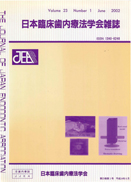Volume 21, Issue 2
Displaying 1-6 of 6 articles from this issue
- |<
- <
- 1
- >
- >|
Review Article
-
2000Volume 21Issue 2 Pages 71-78
Published: 2000
Released on J-STAGE: January 31, 2019
Download PDF (6086K) -
2000Volume 21Issue 2 Pages 79-84
Published: 2000
Released on J-STAGE: January 31, 2019
Download PDF (3645K)
Original Article
-
2000Volume 21Issue 2 Pages 85-88
Published: 2000
Released on J-STAGE: January 31, 2019
Download PDF (2967K) -
2000Volume 21Issue 2 Pages 89-94
Published: 2000
Released on J-STAGE: January 31, 2019
Download PDF (5765K) -
2000Volume 21Issue 2 Pages 95-100
Published: 2000
Released on J-STAGE: January 31, 2019
Download PDF (3946K)
Case Report
-
2000Volume 21Issue 2 Pages 147-149
Published: 2000
Released on J-STAGE: January 31, 2019
Download PDF (933K)
- |<
- <
- 1
- >
- >|
